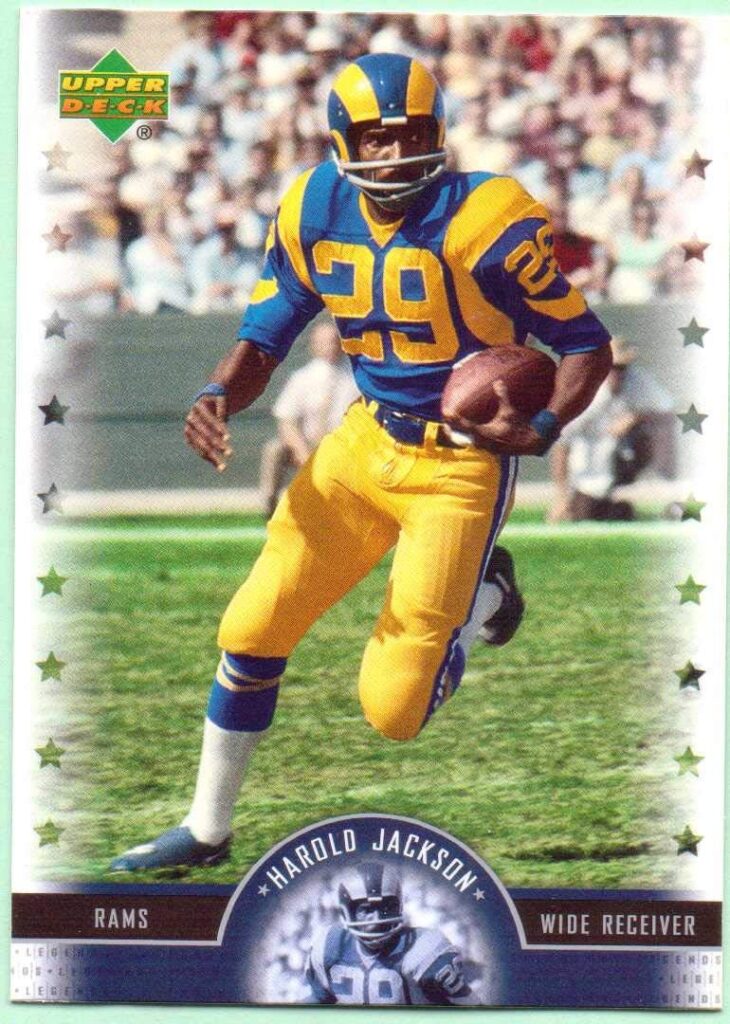Posted on
October 07, 2017 by
Dean Hybl
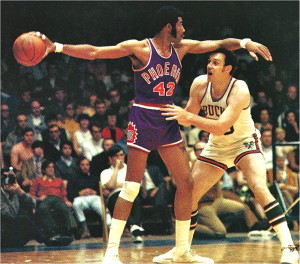
Connie Hawkins was a four-time All-Star with the Phoenix Suns.
In the days before 24-hour sports networks and social media, basketball legends were created in places like the playgrounds of New York City. One of the original playground superstars was Brooklyn native Connie Hawkins, who has passed away at the age of 75.
Before he had ever played a college or professional game, Hawkins had already created a reputation as a player you had to see to believe. His thundering dunks and quick step was a forerunner to Julius Erving, Dominique Wilkins and LeBron James.
Though his professional career started late because he had the misfortune of being associated with a college point-shaving scandal during his freshman year at Iowa, for which he was not implicated, once he reached a greater audience he was as good as advertised.
Shunned by the NBA, Hawkins spent four years showing his dynamic skills as a member of the Harlem Globetrotters.
Hawkins finally began his professional career with the Pittsburgh Pipers of the ABA as a 25 year old during the 1967-68 season. He was an immediate All-Star and league MVP averaging a league best 26.8 points while grabbing 13.5 rebounds per game. During the playoffs, Hawkins averaged 29.9 points to lead them to the ABA Championship. Read the rest of this entry →
Tags: Connie HawkinsPhoenix SunsPittsburgh Pipers
Category
ABA, Basketball, NBA, Sports History
Posted on
October 01, 2017 by
Dean Hybl
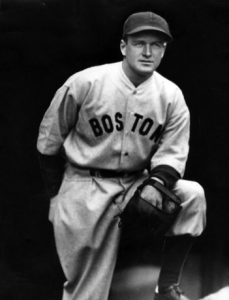
Joe Cronin
In recognition of the start of the baseball playoffs, we recognize as the Sports Then and Now Vintage Athlete of the Month a man who managed pennant winning teams in Washington and Boston and spent more than decade as a player-manager.
When the Boston Red Sox acquired Joe Cronin following the 1934 season they didn’t just get an All-Star player, they also got a new manager. Read the rest of this entry →
Tags: Boston Red SoxJoe CroninWashington Senators
Category
Baseball, Sports History, Vintage Athletes
Posted on
September 03, 2017 by
Dean Hybl
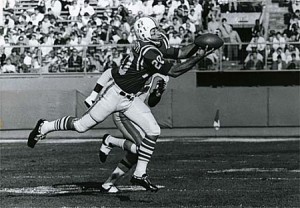
Gino Cappelletti
In recognition of the start of football season, the Sports Then and Now Vintage Athlete of the Month is one of the original stars for the defending Super Bowl Champion New England Patriots.
In many ways, Gino Cappelletti epitomized the early years of the American Football League. While the NFL was becoming more specialized and tougher to break into, the AFL provided former college stars with a new place to play and its “wild west” mentality allowed players to contribute in a wide variety of ways. Read the rest of this entry →
Tags: AFLGino CappellettiNew England Patriots
Category
AFL, Football, Sports History, Vintage Athletes
Posted on
August 26, 2017 by
Dean Hybl
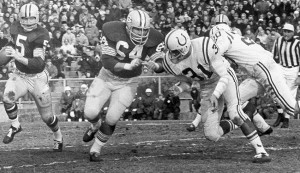
Jerry Kramer (#64) should join his teammate Paul Hornung (#5) in the Pro Football hall of Fame in 2018.
In 1969, former Green Bay Packers offensive lineman Jerry Kramer was selected as the greatest offensive lineman of the first 50 years of the NFL. Unless the Pro Football Hall of Fame selection committee commits a true travesty next February, Kramer will finally be selected to the Hall of Fame as the NFL completes its 98th season.
Much has been written on this site and in many others over the years about how ridiculous it was that Kramer continued to be overlooked for the Hall of Fame. After retiring from the NFL in 1968, Kramer was first a finalist for the HOF in 1974 and was a regular selection finalist nine times between 1974 and 1987 and was also a senior finalist in 1997.
Each time, Kramer failed to the necessary support from the selection committee to earn enshrinement.
Over time, it went from Kramer being an obvious pick, to a theory that there were already a large number of 1960s Packers to in recent year’s disbelief at some of the players and contributors earning induction while Kramer continued to be on the outside.
It has gotten over the last decade to the point where almost every list that looks at potential Hall of Fame candidates listed Kramer as the most deserving player not currently enshrined.
Yet, since 2010 there have been a number of “head scratching” selections, especially among senior candidates (players retired 25 years or more). None of the senior players selected since 2010 were members of the NFL’s 50th Anniversary All-Time team or had played on more than three NFL Championship teams. Read the rest of this entry →
Tags: Green Bay PackersJerry KramerPro Football Hall of Fame
Category
Football, NFL, Pro Football Hall of Fame, Sports History
Posted on
August 21, 2017 by
Tyrion Smith
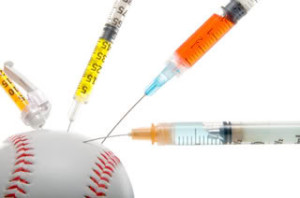 Witnessing the whole BALCO fiasco and long trials of Barry Bonds along with Mark McGwire would have made you wonder that these are the first cases of doping in sports, especially in baseball, but that’s farther from the truth. Yes, the baseball doping was highlighted way more than other incidents of steroid use by athletes in the US, partially because of congressional hearings in 2005 and critically acclaimed movie ‘Bigger, Stronger, Faster’.
Witnessing the whole BALCO fiasco and long trials of Barry Bonds along with Mark McGwire would have made you wonder that these are the first cases of doping in sports, especially in baseball, but that’s farther from the truth. Yes, the baseball doping was highlighted way more than other incidents of steroid use by athletes in the US, partially because of congressional hearings in 2005 and critically acclaimed movie ‘Bigger, Stronger, Faster’.
Initial Phase
The fact is doping history in sports goes all the way back to ancient Rome when chariot racers were used to drink an herbal pre-workout of sorts before races, heightening their focus and endurance. That’s one of the earliest forms (100 AD) of competitive sports known to mankind. Fast forward to 1889, and ironically, a baseball player openly admitted using testosterone, a rather organic form derived from pigs and dog’s testicles. Sure, there were few instances of athletes experimenting with caffeine and liquor here and there, but come on, caffeine and booze can’t be considered doping despite their proclaimed performance enhancing effects.
First Causalities
Soon after the use of testosterone in 1889, the world witnessed the horrors of steroids in 1896 when Ephedrine intake caused death of English cyclist, A.Linton. Then in 1904, Tom Hicks collapsed at St. Louis marathon, and though he won the event, doctors proved use of Strychinine and Cognac.
The Booming Period
After that we saw a boom in the use of drugs that enhance performance of humans to somewhat super human level, across sports and in wars as well. Call it leaked secretive documents or conspiracy theories, soldiers in WW II were given Amphetamines to boost their endurance and focus, both Allied and Axis.
Finally, we see the mid-1900s, when the use of anabolic steroids was rampant and we witnessed highly tuned muscular physiques. It was the era of superiorly muscular bodybuilders like Sergio Oliva, Arnold and later Dorian Yates, Ronnie Coleman and Phil Heath ushered a ground-breaking phenomenon where human limits were pushed to the max. Soon HGH joined the list of anabolic doping agents as the most potent activist. Ironically, the very sport of bodybuilding highlighted the absolute potential of HGH and doping agents, in addition to its side effects. The number of causalities and deaths directly related to abuse of HGH, insulin and anabolic steroids, in bodybuilding is among the highest and the facts are widely documented on social media. However, that happens only when you misuse them. Learn more about HGH here. Read the rest of this entry →
Tags: Barry BondsBen JohnsonDopingMark McGwire
Category
Baseball, General, Health & Fitness, Sports Fitness, Sports History
Posted on
August 18, 2017 by
Peter Addison

The Premier League is celebrating 25 years.
As the Premier League celebrates its twenty-five year anniversary, there can be no doubt that football has changed irrecoverably over that period. It seems that the modern game is all about money, and the grip of the money giants means that plucky upstarts like Nottingham Forest, Aston Villa and Blackburn Rovers can no longer hope to challenge the elite as they have in the past (we’ll excuse Leicester City’s 2015-16 EPL win as an anomaly).
The question is, how do ex-Pros view the cash-cow that modern football has become? Are they resentful of the money that current pros earn – after all, Middlesbrough’s Britt Assombalonga, a player who’s never even played in the top flight, is reportedly on £40,000 a week.
In a recent Emile Heskey interview at the fan-created site AskFans.co.uk, the former Leicester City, Liverpool and England striker gave his thoughts. “The game’s quicker, people are looking after their bodies better, and there are certain more athletes around then when I first started,” said Heskey. He also cited Leicester’s Jamie Vardy and new Manchester United record signing Romelu Lakuku as modern-day players he would like to have played with.
One player who has seen it all is George Haigh. You’ve probably not heard of him, but currently, at a staggering one hundred and two years of age, Haigh is the oldest surviving professional footballer, having made his debut for Stockport County in 1936. He doesn’t actually see much difference between the modern era and sepia-tinged times. “I would’ve found it easy playing today; centre-half would’ve been dead easy for me knowing what I know now, I’d have been an international! And the equipment is so much better; the boots were so heavy in my day, especially when it was wet. In the modern era, David Beckham is probably the one who stands out, I’d like to have taken him on.” Read the rest of this entry →
Tags: Frank LampardGary NevillePremier Leaguesoccer
Category
soccer, Sports History






